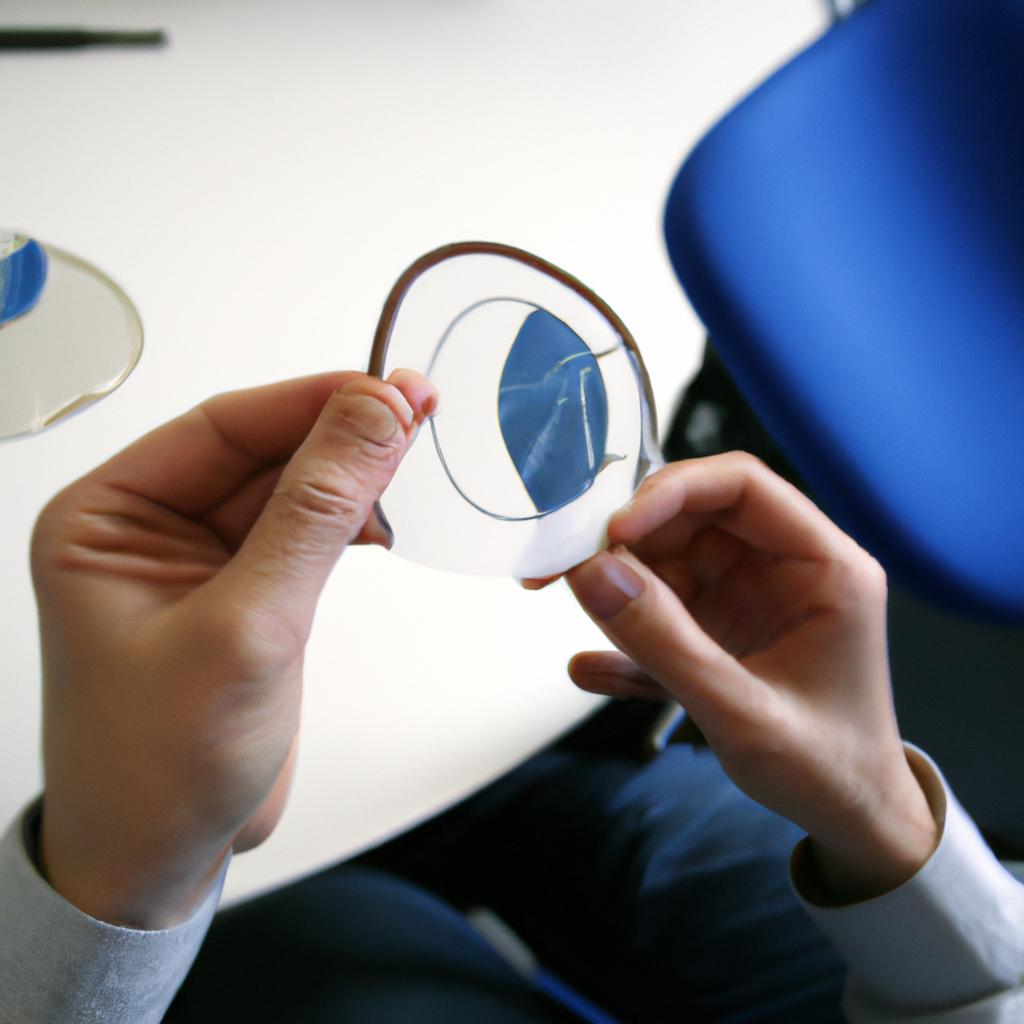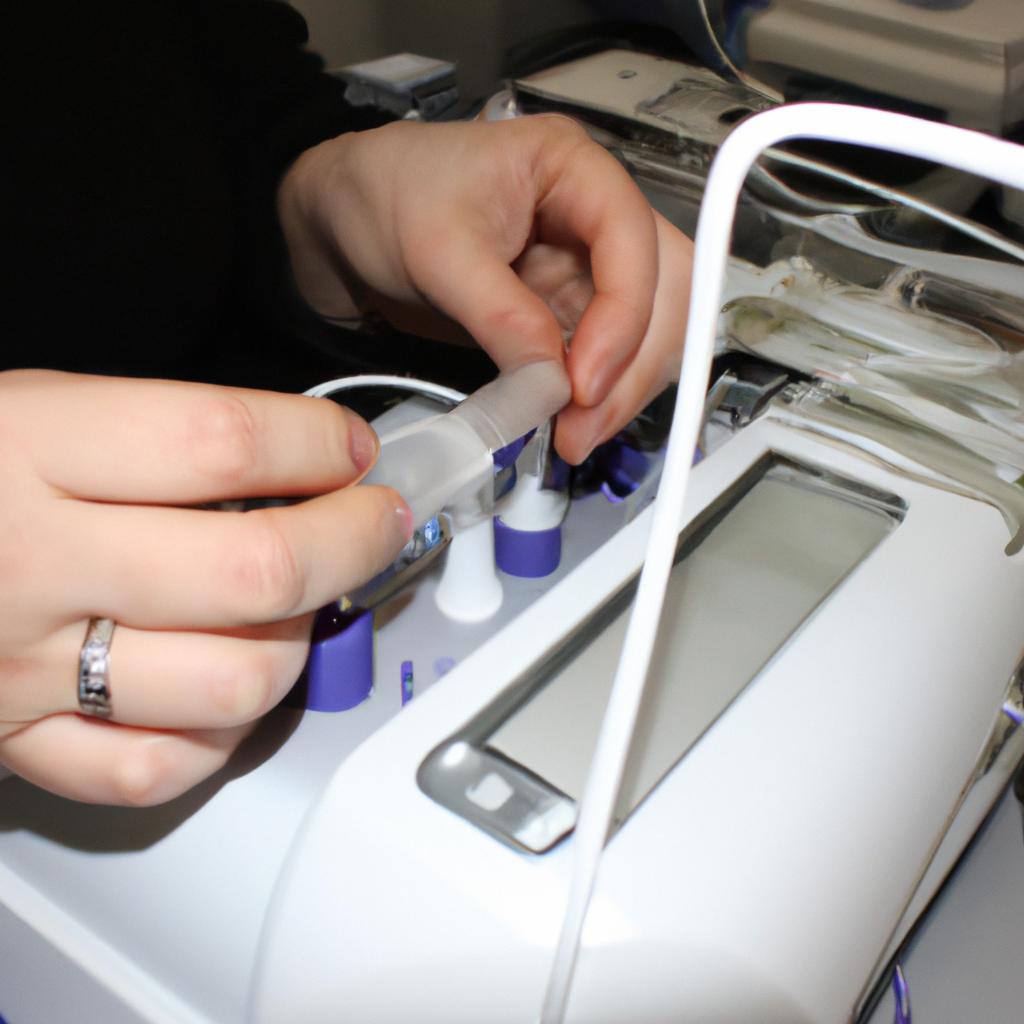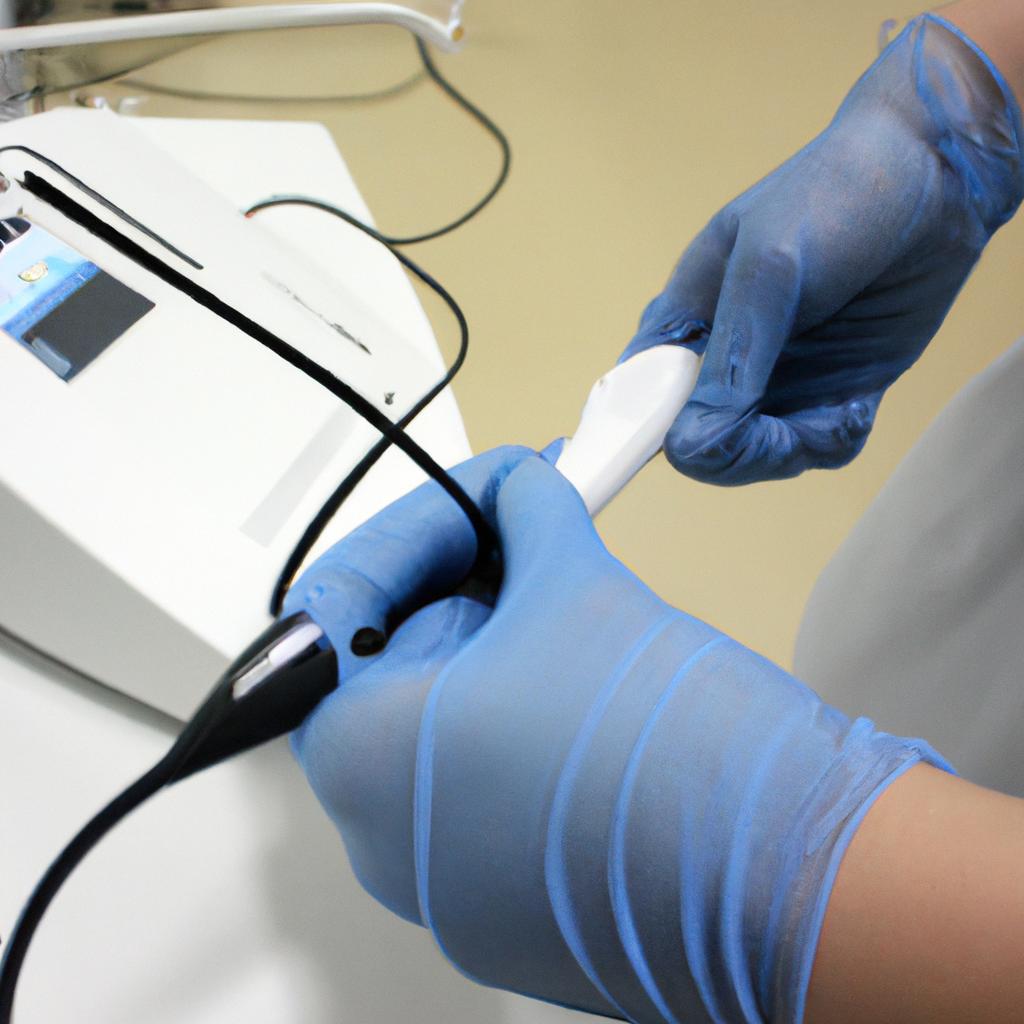Materials selection is a critical aspect of engineering in the field of medicine, particularly in medical device design. The choice of materials used can greatly impact the performance, safety, and effectiveness of these devices. For instance, consider the case study of a hip replacement implant. In this scenario, selecting the appropriate material for both the implant and its accompanying components is crucial to ensure proper functionality and longevity.
The process of materials selection involves careful consideration of various factors such as biocompatibility, mechanical properties, corrosion resistance, and sterilization compatibility. Biocompatibility refers to the ability of a material to interact with living tissue without causing adverse reactions or harm. Given that medical devices often come into contact with biological systems within the body, it is imperative that the selected materials are non-toxic and do not induce inflammation or immune responses.
Mechanical properties play a significant role in determining how well a medical device performs its intended function. The chosen materials must possess adequate strength, stiffness, and durability to withstand physiological forces exerted on them during use. Furthermore, considerations like wear resistance and fatigue life become vital when designing implants expected to last for extended periods.
Corrosion resistance is another crucial factor in materials selection for medical devices since many will be exposed to bodily fluids containing electrolytes and other corrosive substances. Materials with high corrosion resistance, such as stainless steel or titanium alloys, are commonly used in medical device design to ensure longevity and prevent degradation over time.
Sterilization compatibility is also an important consideration in materials selection. Medical devices need to be sterilized before use to eliminate any potential pathogens or contaminants. Different sterilization methods, such as steam autoclaving, ethylene oxide gas, or gamma radiation, can have varying effects on materials. It is essential to choose materials that can withstand the chosen sterilization method without compromising their structural integrity or functionality.
In addition to these factors, cost, availability, manufacturability, and regulatory requirements must also be taken into account during the materials selection process. Balancing all of these considerations ensures that the chosen materials meet both performance requirements and practical constraints.
To select the most suitable material for a specific medical device application, engineers often rely on a combination of experimental testing and computational modeling techniques. This allows them to evaluate different candidate materials based on their properties and performance under relevant conditions.
Overall, careful materials selection is crucial in medical device design to ensure optimal performance, patient safety, and long-term reliability of these critical tools in healthcare.
Understanding the Role of Materials in Medical Device Design
In the field of medical device design, materials play a crucial role in ensuring the safety and effectiveness of these life-saving technologies. The choice of materials can greatly impact the performance, durability, biocompatibility, and overall success of a medical device. To illustrate this point, let us consider the case study of an implantable cardiac pacemaker.
When designing an implantable cardiac pacemaker, engineers must carefully select materials that are not only biocompatible but also possess excellent electrical conductivity and mechanical strength to ensure proper functioning within the human body. In addition to these fundamental requirements, other factors such as corrosion resistance, fatigue resistance, and sterilization compatibility need to be taken into account to guarantee long-term reliability.
The importance of material selection extends beyond just the functionality aspect; it also has significant implications for patient comfort and well-being. For instance, using lightweight materials with smooth surfaces can enhance patient comfort by minimizing discomfort or irritation caused by prolonged contact with the skin. Furthermore, incorporating antimicrobial properties into certain components can help mitigate the risk of infections associated with medical procedures or implanted devices.
To emphasize the multifaceted nature of materials selection in medical device design, consider the following emotional bullet points:
- Ensuring patient safety: Selecting materials that minimize potential risks and adverse reactions during use.
- Enhancing quality of life: Choosing materials that promote comfort and reduce user discomfort.
- Improving longevity: Utilizing durable materials that withstand wear and tear over time.
- Advancing innovation: Exploring novel materials with unique properties to push boundaries in medical device technology.
Additionally, we can visualize key considerations through a table:
| Considerations | Importance |
|---|---|
| Biocompatibility | High |
| Electrical Conductivity | Medium |
| Mechanical Strength | High |
| Corrosion Resistance | Medium |
With careful consideration of these factors, engineers can make informed decisions regarding material selection for medical devices. In the subsequent section on “Factors to Consider in Materials Selection for Medical Devices,” we will delve further into the specific aspects that influence these choices and explore how they impact device performance and patient outcomes.
Factors to Consider in Materials Selection for Medical Devices
In the previous section, we explored the vital role that materials play in medical device design. Now, let us delve deeper into the factors to consider when selecting materials for these devices. To illustrate this, let’s consider a hypothetical case study involving the design of a prosthetic limb.
When designing a prosthetic limb, several key considerations come into play regarding material selection. Firstly, durability is crucial as the limb should be able to withstand frequent use and potential impacts without compromising its functionality. Secondly, biocompatibility is essential to ensure that the material does not cause adverse reactions or reject by the human body. Additionally, weight and strength are significant factors since an ideal prosthetic should be lightweight for ease of mobility while providing sufficient support.
To better understand how different materials can fulfill these requirements, let’s examine a comparison table:
| Material | Durability | Biocompatibility | Weight |
|---|---|---|---|
| Titanium | High | Excellent | Moderate |
| Carbon Fiber | Very high | Good | Light |
| Silicone | Moderate | Excellent | Light |
As depicted in the table above, titanium offers excellent durability and biocompatibility but has moderate weight. On the other hand, carbon fiber provides very high durability with good biocompatibility and light weight. Lastly, silicone exhibits moderate durability along with excellent biocompatibility and lightness. By assessing such characteristics, engineers can make informed decisions based on specific requirements within their medical device designs.
In summary, careful consideration must be given to various aspects when selecting materials for medical devices like prosthetic limbs. Factors such as durability, biocompatibility, weight, and strength all contribute significantly to achieving optimal solutions in medical device design projects.
Moving forward into our next section about “Biocompatibility: Ensuring the Safety of Medical Devices,” we will explore how materials used in medical devices undergo rigorous testing to ensure their compatibility with the human body.
Biocompatibility: Ensuring the Safety of Medical Devices
In the previous section, we discussed the various factors that need to be considered when selecting materials for medical devices. Now, let’s delve deeper into one of the most critical aspects: ensuring biocompatibility and the safety of these devices.
Biocompatibility refers to the ability of a material to perform its intended function without eliciting any adverse reactions or harm within living tissues. To illustrate this concept, let’s consider an example. Imagine a patient requiring a hip replacement surgery due to severe osteoarthritis. The surgeon must carefully select a material for the artificial hip joint that will not cause any allergic reactions or tissue rejection post-implantation.
When it comes to assessing biocompatibility, several key points should be taken into account:
- Cytotoxicity: The potential toxicity of a material on cells is evaluated by examining how it affects cell viability and growth.
- Immunogenicity: This refers to the likelihood of provoking an immune response from the body, which can lead to inflammation or rejection.
- Hemocompatibility: Blood-contacting devices must be compatible with blood components and prevent clotting or hemolysis.
- Long-term stability: Materials should maintain their integrity over time without undergoing degradation or releasing harmful substances.
To better understand these considerations, take a look at the following table showcasing different types of commonly used materials in medical devices and their associated biocompatible characteristics:
| Material | Cytotoxicity | Immunogenicity | Hemocompatibility | Long-Term Stability |
|---|---|---|---|---|
| Titanium | Low | Low | Excellent | Very Good |
| Stainless Steel | Moderate | Moderate | Good | Good |
| Silicone | High | Low | Poor | Fair |
As you can see, titanium exhibits excellent biocompatibility, making it a preferred choice for many medical devices. On the other hand, silicone may have limitations due to its poor hemocompatibility and higher cytotoxicity.
By carefully considering these factors and conducting thorough biocompatibility assessments, engineers can ensure that the materials selected for medical devices are safe and compatible with the human body.
Material Properties and their Impact on Device Performance
Biocompatibility plays a crucial role in ensuring the safety and efficacy of medical devices. However, it is not the only factor that engineers must consider when designing these life-saving tools. Material properties also have a significant impact on device performance, durability, and functionality. Understanding how different materials behave under various conditions is essential for creating successful medical devices.
Consider the case of an implantable cardiac pacemaker, which relies on electrical components to regulate heart rhythm. In this example, material selection becomes critical in order to achieve optimal device performance. The housing of the pacemaker needs to be made from a biocompatible material that can withstand physiological fluids and provide electrical insulation. Additionally, the lead wires connecting the pacemaker to the heart muscles require materials with high flexibility and fatigue resistance to endure constant movement without fracturing or malfunctioning.
When selecting materials for medical devices, engineers must take into account several key factors:
- Biocompatibility: Ensuring that all materials coming into contact with body tissues do not cause adverse reactions such as inflammation or rejection.
- Mechanical Properties: Considering strength, elasticity, hardness, and other mechanical characteristics needed for specific applications.
- Chemical Compatibility: Assessing potential interactions between materials and drugs or bodily fluids.
- Sterilization Compatibility: Determining whether materials can withstand common sterilization methods without degradation.
To better understand these considerations, let’s explore them in more detail through a table:
| Factor | Consideration |
|---|---|
| Biocompatibility | – Materials should not trigger immune responses.- They must not release harmful substances into surrounding tissues.- Surface properties affect cell adhesion. |
| Mechanical Properties | – Strength determines load-bearing capacity.- Elasticity affects conformability.- Hardness impacts wear resistance. |
| Chemical Compatibility | – Materials should remain stable when exposed to chemicals found within the human body (e.g., pH levels, enzymes).- Potential leaching and degradation must be considered. |
| Sterilization Compatibility | – Materials should withstand common sterilization methods such as heat or chemical exposure without significant deterioration. |
In summary, material selection in medical device engineering involves a meticulous evaluation of biocompatibility, mechanical properties, chemical compatibility, and sterilization requirements. These considerations are vital to ensure the successful performance and durability of devices within the human body.
As we delve into the next section on “Current and Emerging Materials in Medical Device Engineering,” it is essential to explore how advancements in materials science continue to shape the field of medical device design and enhance patient outcomes.
Current and Emerging Materials in Medical Device Engineering
Section H2: Material Properties and their Impact on Device Performance
Transition from the previous section:
Having examined the crucial role of material properties in determining device performance, we now turn our attention to exploring current and emerging materials in medical device engineering. To illustrate this, let us consider a hypothetical scenario where a team of engineers is developing an innovative diagnostic device for detecting early-stage cancer.
In this hypothetical case study, the engineers are tasked with selecting suitable materials that can enhance the device’s sensitivity while ensuring biocompatibility and durability. They carefully assess various options based on factors such as cost, availability, mechanical strength, electrical conductivity, and compatibility with biological tissues. After extensive research and prototyping, they identify a combination of advanced polymers and nanomaterials that exhibit exceptional sensing capabilities without compromising patient safety.
To further highlight the significance of materials selection in medical devices, let us explore some key aspects:
-
Biocompatibility: Selecting materials that are compatible with human tissues is critical to ensure safe interactions between the device and the body. This involves considering factors like immunological response, cytotoxicity potential, biofilm formation tendency, and corrosion resistance.
-
Mechanical Strength: Devices used in medical applications often undergo repetitive loading or stress due to regular use or external forces. Choosing materials with adequate strength properties helps prevent structural failure or deformation over time.
-
Chemical Stability: Some medical procedures involve exposure to corrosive substances or fluctuating pH levels. Materials must be chemically stable under these conditions to maintain functionality and avoid any adverse reactions when interacting with bodily fluids.
-
Electrical Conductivity: In certain types of medical devices (e.g., pacemakers), electrical conductivity plays a vital role in proper functioning. The choice of conductive materials should prioritize low resistivity for efficient signal transmission within the body.
As we delve into cutting-edge advancements in medical device engineering, it becomes increasingly evident that materials selection is a dynamic and evolving field. To stay at the forefront of innovation, engineers must continually explore new possibilities offered by emerging materials such as shape memory alloys, bioabsorbable polymers, graphene-based composites, and bioceramics.
Understanding the importance of selecting appropriate materials for medical devices lays the foundation for exploring regulatory considerations in their design. By complying with stringent regulations and standards, manufacturers can ensure both patient safety and efficacy. Let us now turn our attention to discussing these critical aspects in detail.
Regulatory Considerations for Materials in Medical Device Design
Building upon the knowledge of current and emerging materials in medical device engineering, this section delves into the crucial regulatory considerations that influence material selection in medical device design. By exploring these requirements, engineers can ensure that their chosen materials meet the necessary standards for safety, efficacy, and reliability.
To illustrate the importance of regulatory compliance, let us consider a hypothetical case study involving the development of an implantable pacemaker. The pacemaker’s housing must be composed of biocompatible materials to prevent adverse reactions within the body. In addition to meeting functional requirements such as durability and electrical insulation, it is essential to comply with relevant regulations governing implantable medical devices.
When selecting materials for medical devices, engineers must navigate several key considerations:
- Biocompatibility: Ensuring that all components coming into contact with bodily tissues are non-toxic and do not provoke inflammatory or immune responses.
- Sterility: Maintaining sterility throughout manufacturing processes to minimize contamination risks during implantation.
- Chemical Stability: Choosing materials resistant to degradation from various biological environments and compatible with sterilization methods like autoclaving or ethylene oxide gas exposure.
- Mechanical Properties: Selecting materials with appropriate strength, flexibility, and fatigue resistance to withstand physiological forces over extended periods.
| Material | Advantages | Disadvantages |
|---|---|---|
| Titanium alloy | High strength | Expensive |
| Silicone rubber | Flexibility | Potential for leaching |
| Stainless steel | Cost-effective | Susceptible to corrosion |
| Polycarbonate | Transparency | Limited chemical resistance |
As shown above, each material choice entails trade-offs between desirable properties and associated drawbacks. By carefully weighing these factors against regulatory requirements, engineers can make informed decisions that meet both performance and safety standards.
Ultimately, the selection of materials in medical device design must align with stringent regulations to ensure patient well-being. Consequently, engineers should collaborate closely with regulatory bodies to understand and comply with specific guidelines relevant to their devices. This partnership facilitates the development of innovative and reliable medical devices that improve patient outcomes while adhering to essential regulatory considerations.




